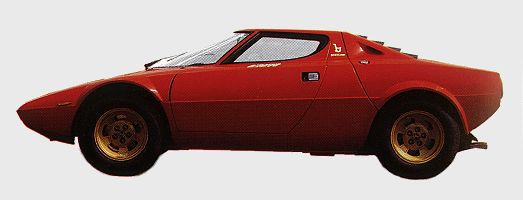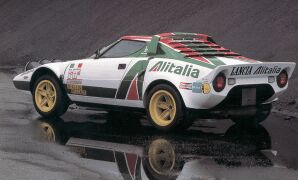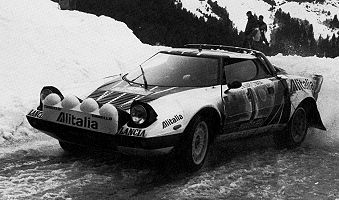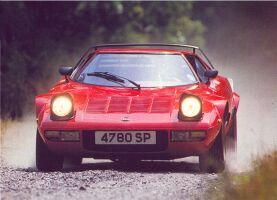With homologation requiring the production
of 500 cars, Lancia began entering the Stratos in events which also allowed
for prototype cars in 1972 (its first event was the Tour de Corse of that
year, driven by Munari) and continued through 1973 (its first victory was
in the Spanish rally of that year, again driven by Munari). That year also
saw the appearance of the first 24 valve versions, producing around 270bhp
compared to the 230bhp of the 8V cars. At the end of 1973 production of
the actual 500 began, but although Bertone had built all 500 chassis by
March 1974 homologation was first achieved in October of that year. That
allowed enough time for the Stratos to take victory in, amongst others,
the Sanremo and Tour de Corse. Together with the points gathered by the
Fulvia, it was enough for Lancia to win the World
Makes Championship. 1974 also saw the first Stratos turbo, with 350bhp,
make some racing appearances.
In rallying in 1976 Lancia again won the
World Makes Championship (winning the Monte Carlo, Portugal, Tour de Corse
and Sanremo), whilst Darniche won the European Rally Drivers Championship
driving a Stratos, and Franz Wurz won the European
Although the works effort was toned down
to avoid competing with the new Fiat 131s, in 1977 the winning continued.
Darniche again won the European Rally Drivers Championship although the
Le Mans entry that year retired. New regulations in 1978 resulted in only
the 12V cylinder head being allowed, and numerous other changes. This dropped
the power down to around 270bhp from the 300bhp which the 24V cars had
been giving. Despite ths Carello won the European Rally Drivers Championship.
In 1979 the Stratos ceased to be an official
works car, but the winning still went on, primarily by Darniche who even
managed a historical win on the Monte Carlo that year.
Finally a brief comment on the number of
cars actually made. The figures quoted range from about 450 up to 1000.
There is no 'official' figure, but the generally accepted number is around
490. In
1970, at the Turin Motorshow, Bertone showed a radical concept car called
Stratos
powered by a Fulvia HF 1600 engine, but mounted in the centre of the chassis
driving the rear wheels. With the approval of Lancia, development began
of a more practical sports car based on this design and one year later,
again at the Turin Motorshow, the Lancia Stratos HF was shown. Retaining
the same basic idea, but with many changes (such as the addition of doors
!), the Stratos HF was now powered by a transverse 2.4-litre Ferrari Dino
V6 engine. This prototype was actually later fitted with a Fiat
132 2 litre engine, but that project went no further. A second development
prototype was also built. These early cars used double-wishbone suspension
at the rear, but problems in development led to this becoming a modified
MacPherson strut system.
In
1970, at the Turin Motorshow, Bertone showed a radical concept car called
Stratos
powered by a Fulvia HF 1600 engine, but mounted in the centre of the chassis
driving the rear wheels. With the approval of Lancia, development began
of a more practical sports car based on this design and one year later,
again at the Turin Motorshow, the Lancia Stratos HF was shown. Retaining
the same basic idea, but with many changes (such as the addition of doors
!), the Stratos HF was now powered by a transverse 2.4-litre Ferrari Dino
V6 engine. This prototype was actually later fitted with a Fiat
132 2 litre engine, but that project went no further. A second development
prototype was also built. These early cars used double-wishbone suspension
at the rear, but problems in development led to this becoming a modified
MacPherson strut system.
 1975
saw Lancia dominate and win the World Makes Championship, including victories
on the Monte Carlo, Swedish, Tour de France, Tour de Corse and Sanremo.
A semi-works Stratos turbo, prepared by Facetti, was also entered in the
European GT Championship, but proved uncompetitive. The opportunity was
used, however, for further development, and in 1976 as well as the Facetti
cars, there appeared works Lancia Stratos turbo's in the new World Championship
for Makes for Group 5 cars. these cars used a KKK turbo and Kugelfischer
fuel injection to produce 480bhp with a 12V cylinder head and 0.8bar of
boost. A longer rear body was designed by Bertone to improve the aerodynamics.
1975
saw Lancia dominate and win the World Makes Championship, including victories
on the Monte Carlo, Swedish, Tour de France, Tour de Corse and Sanremo.
A semi-works Stratos turbo, prepared by Facetti, was also entered in the
European GT Championship, but proved uncompetitive. The opportunity was
used, however, for further development, and in 1976 as well as the Facetti
cars, there appeared works Lancia Stratos turbo's in the new World Championship
for Makes for Group 5 cars. these cars used a KKK turbo and Kugelfischer
fuel injection to produce 480bhp with a 12V cylinder head and 0.8bar of
boost. A longer rear body was designed by Bertone to improve the aerodynamics.
 Rallycross Championship also in a Stratos. A Stratos turbo also finished 20th at Le
Mans in that year.
Rallycross Championship also in a Stratos. A Stratos turbo also finished 20th at Le
Mans in that year.
Technical Details
for the road cars :
| Engine | 2418cc (92.5x60mm) 65º dohc V6 producing 190bhp @ 7400rpm with three Weber 40IDF carburettors |
| Driveline | transverse engine at centre/rear with rear wheel drive |
| Suspension | front : double wishbone with telescopic dampers and coil springs plus anti-roll bar
rear : lower wishbone with strut with telescopic dampers and coil springs plus anti-roll bar wheelbase : 2180mm front track : 1433mm rear track : 1457mm |
| Brakes | front : ventilated discs (diameter 10.7 inches)
rear : ventilated discs (diameter 10.9 inches) handbrake operating on the rear wheels by cable |
| Gearbox | 5 speed manual (ZF)
single dry plate clutch with hydraulic actuation |
| Steering | Rack and pinion
3.2 turns lock-to-lock |
| Kerb weight | 980kg |
the Group 4 cars had the following differences :
| Engine | 2418cc 65º V6 producing 270bhp @ 7400rpm with three Weber 44IDF carburettors |
| Suspension | front track : 1490mm
rear track : 1570mm |
| Gearbox | multiplate clutch |
| Kerb weight | 880kg |
Click here for a sectioned drawing of a Stratos.
Lancia Stratos Books :
buy
them online here (in association with
Amazon)
 Lancia
Road Test Book : Lancia Stratos 1972-85 Lancia
Road Test Book : Lancia Stratos 1972-85
Several articles on the car, its development, history, competition use etc.. and some reports on less well known variants. |
Edited by R.M.Clarke, 1985 |
For more books Lancia's, see our Online Bookstore
Stratos comment form
Your Comments
Probably the worlds most
beautiful sports car, I would love to see another ling of the stratos produced.
I would pick this car over most Ferraris and Porsches because of the style of it.
When you say a "dream" car
I think just at Lancia Stratos. It's my favourite rally car, as beutiful
as fast. (Giuseppe C., Italy)
The most beautiful and desirable car ever made. A true dream car! (Danny D, Canada)
There is also a list of all our picture galleries (including museums, motorshows and various events).
Wallpapers/Desktop Backgrounds of numerous Lancia's, including the Stratos, are available to download.
See also our Lancia advertisements gallery, where several adverts can be seen.

Use
the buttons at the top to navigate further, or
Copyright © 2000 to 2008 CarsfromItaly